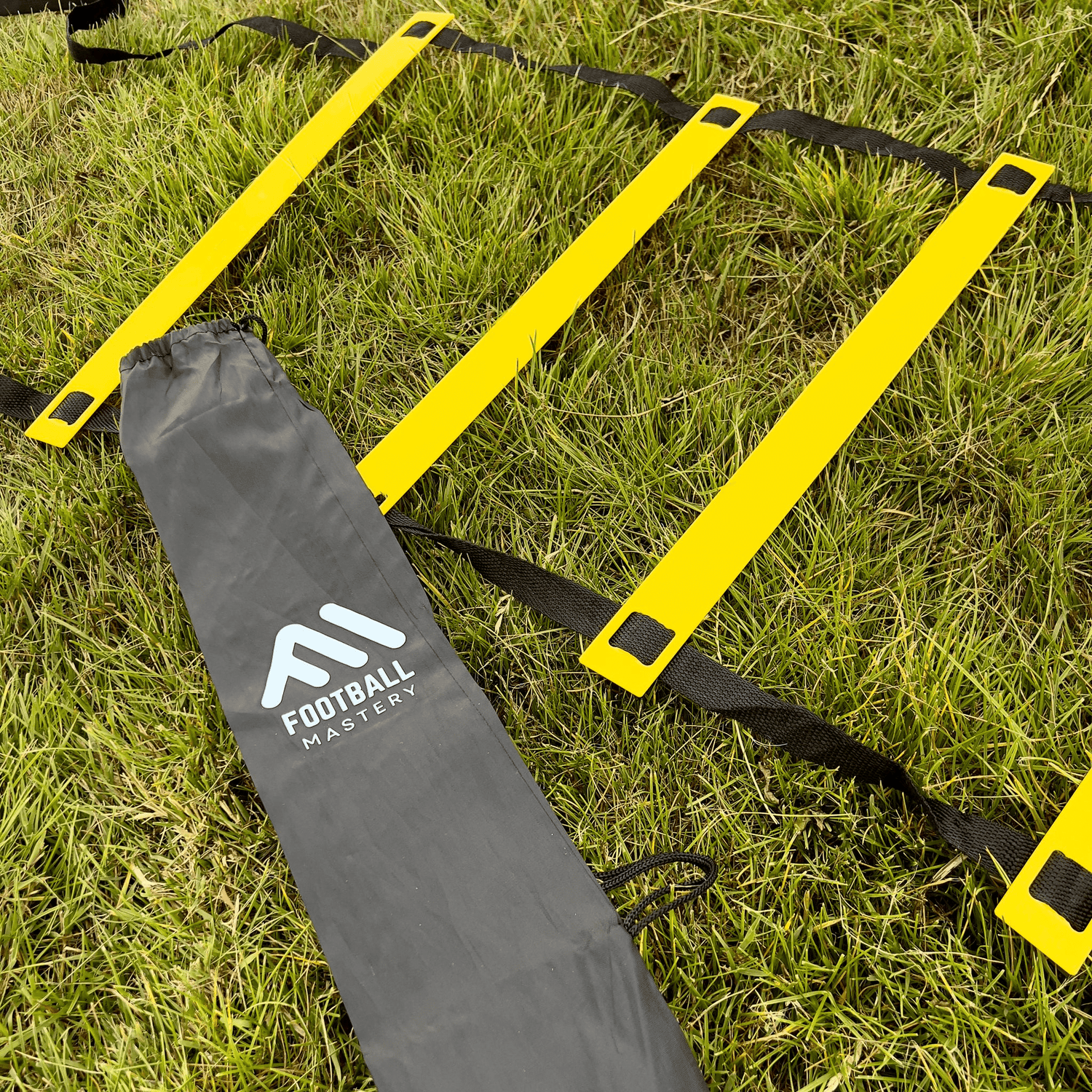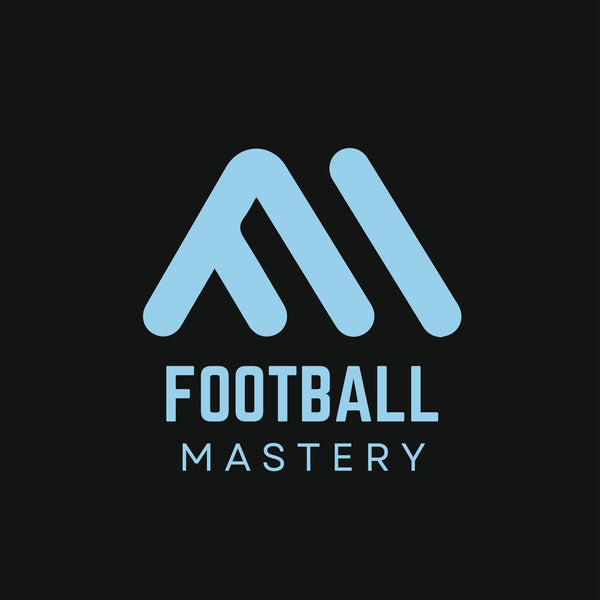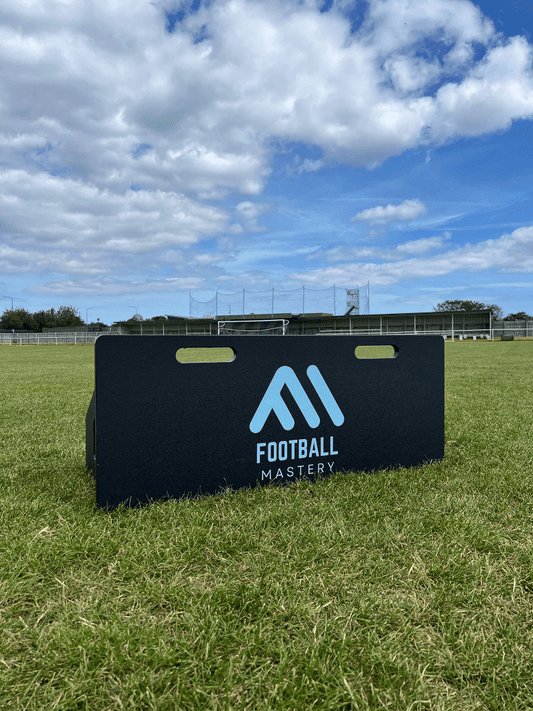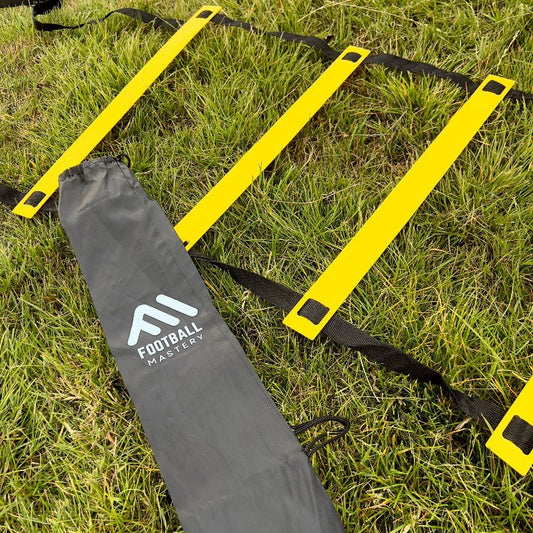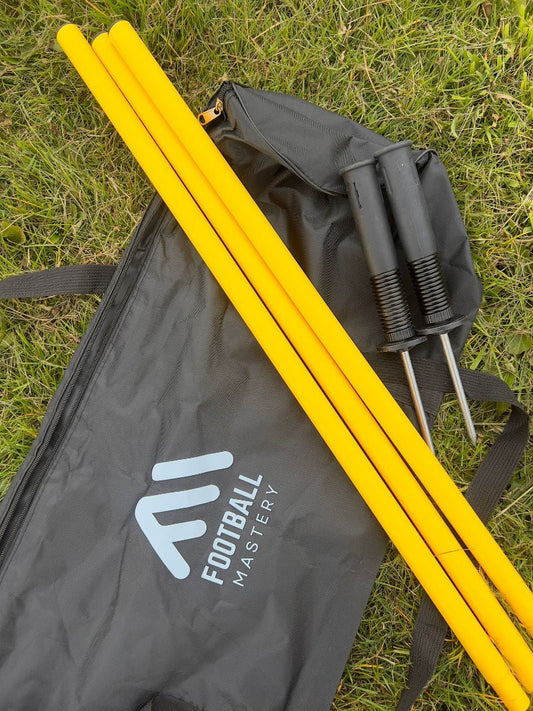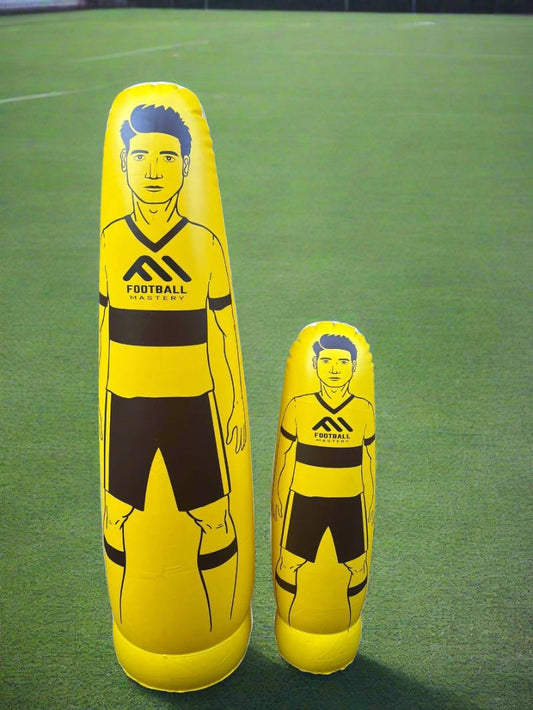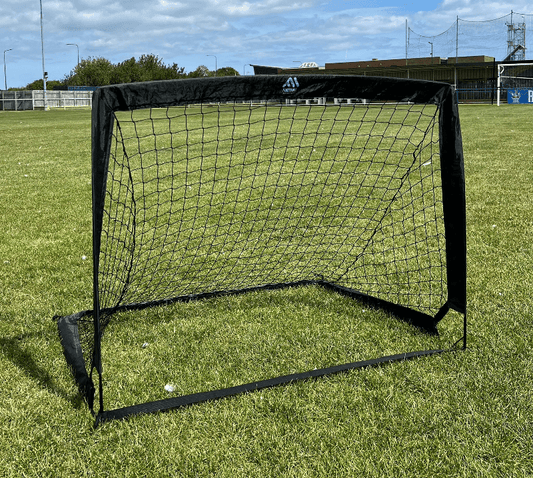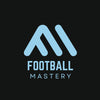
Best Portable Football Rebound Boards for Flexible Training
Share
If you're a coach, parent, or player searching for a game-changing training tool, this article covers everything you need to know about portable football rebound boards. We explore their benefits for ball control, reaction speed, and overall technique development. You'll discover the key features that matter most—like foldability, high-rebound tension, and dual-sided play—and how to pick the right model for your space and skill level. We'll also highlight Football Mastery's standout rebound boards and bundles, with internal links to collections, products, and useful buying options. Expect expert insights, real use-case applications, and tips on how to maximise your training whether you're at home, on grass, or at the club.
The Modern Training Essential: Why Rebound Boards Matter
Football training is evolving—gone are the days when cones and running drills were enough. Today’s players, from youth academy hopefuls to elite goalkeepers, need tools that mimic match situations and build true mastery. That’s where football rebounders shine.
Whether it’s to enhance passing accuracy or refine a first touch, a well-designed rebound board simulates live game interactions. It creates fast, reactive drills that help players improve decision-making and control in tight spaces.
At Football Mastery, we design all of our equipment with one core belief: training tools should be as dynamic and versatile as the game itself.
“A rebound board isn’t just a tool—it’s a training partner that never gets tired.”
What Makes a Great Portable Rebounder?
When looking for the best portable football rebound boards for flexible training, several key features separate the exceptional from the average. Here’s what you should be focusing on:
1. Portability & Convenience
A foldable or flat-packed design allows players to carry their rebounder to the park, club, or back garden. Portability is essential for anyone training in multiple locations.
Look for features like:
-
Quick setup
-
Integrated carrying bag
-
Lightweight but stable materials
Our Football Mastery Rebound Board ticks all these boxes. Built with portability in mind, it’s ideal for both indoor training and portable for away games.
2. Durability & Design
Rebound boards take a beating. High-speed shots, repeated volleys, and harsh weather conditions demand durable construction and a high-rebound tension surface. Some advanced boards include shock absorption and impact-resistant materials to extend longevity.
A one-piece frame or modular system can add to a rebounder’s durability while still offering training flexibility.
Tip: Boards with spring clips or fast net fastenings are often easier to maintain over time.
3. Functionality & Skill Versatility
Good rebounders should allow for:
-
Dual angles for varied ball trajectories
-
Compatibility with goalkeeper warm-ups
-
Support for close-quarter drills or longer passing accuracy work
-
User-adjustable rebound zones for tailored training
Explore our full Rebound Board Collection to see how different styles serve various training needs—whether you’re fine-tuning your technique or building your first touch from scratch.
Tailored for Every Player
Rebounders shouldn’t just be for academy setups. At Football Mastery, our products are built for:
-
Youth and adult players
-
Goalkeepers and outfielders
-
Coaches needing club-grade equipment
-
Parents building a home training zone
-
Players seeking the best rebounder for solo football training
In particular, our rebound boards shine during individual training sessions where repetition and muscle memory are key. From volleying practice to weaker foot training, the board adapts to any drill you design.
Want to get more for your setup? Check out our Football Mastery Bundles, which combine rebound boards with other essential training tools to maximise performance without breaking your budget.
Master the Drill: Real-World Rebounder Training Techniques
Once you’ve chosen the right portable football rebounder, the real magic begins when you integrate it into your daily routine. Whether you’re a youth player trying to refine your touch or a seasoned coach setting up team sessions, the rebound board becomes an unlimited training partner—ready anytime, anywhere.
Here are a few of the most effective training drills and how to get the most out of your equipment:
1. Passing & First Touch Drills
Set your board at a low angle and stand around 2–3 metres away. Strike the ball cleanly, control the return, and pass again. This simulates tight space midfield play and improves:
-
Passing accuracy
-
First touch
-
Weaker foot training
For variation, alternate between instep passes, laces, and one-touch returns.
2. Volleying & Reaction Drills
Angle the rebound board slightly upwards to create unpredictable ball movement. Use this for solo volleys or to warm up goalkeepers with dynamic returns. This drill develops:
-
Reaction speed
-
Ball control under pressure
-
Timing and coordination
You’ll especially appreciate this setup if you're using a dual-sided rebounder or one with trajectory control built-in.
“Don’t chase more reps—chase better reps. A rebounder keeps your quality high, every single session.”
Choosing the Right Rebounder for Your Space & Style
Footballers train in varied environments—from astro pitches and garages to public fields and home gardens. That’s why understanding rebounder compatibility with your space is just as important as picking the right features.
Ideal for Garden Practice:
For smaller areas, such as patios or gardens, a compact football rebound net for backyards is ideal. Our space-saving Rebound Board is light enough for kids to carry and solid enough for adult players to train seriously.
Look for flat-packed storage and weather-resistant materials if you’re leaving it outdoors regularly.
Best for Club Sessions:
Larger boards or goal rebounders work well in team settings, especially when used in multi-surface environments like artificial turf or sports halls. Here, you’ll want a club-grade solution with more angle variety and fast returns.
Browse our full collection of rebound boards to find the best fit for your setup, whether you’re training one-on-one or with an entire squad.
The Versatility of Multi-Skill Rebounders
Don’t box yourself into just one training use. Many modern rebounders now combine functionality with adaptability. Our 2-in-1 and 4-in-1 rebounders support multiple styles of play, often adjustable on the fly to switch between:
-
Ground passes
-
Chest-height returns
-
High volleys
-
Keeper drills
This kind of modular system allows coaches and players to build skill-specific sessions quickly.
Pair your rebounder with cones, mannequins, and finishing drills for a complete training circuit—especially when used in tandem with one of our Football Mastery Bundles.
Take It Anywhere: Rebounders On The Go
Portable doesn’t just mean “easy to lift.” It means you can rely on your training aid wherever the game takes you. Whether it’s:
-
A pre-match goalkeeper warm-up
-
Indoor training during winter months
-
Summer drills on uneven grass pitches
You’ll want a rebounder that sets up in under a minute and packs down just as fast. Some of our models even come with a carrying bag, ideal for players who move between locations often.
Designed for All Ages & Skill Levels
One of the key advantages of the modern football rebound board is its universal adaptability. Whether you're introducing a 7-year-old to their first individual training session or refining a semi-pro's one-touch passing under pressure, the right rebounder bridges the gap between age, ability, and ambition.
At Football Mastery, we’ve built our boards to scale with you. You don’t need to replace your equipment as you progress—our rebounders grow with your game.
For Young Players
Kids learning foundational technique benefit hugely from:
-
Slower rebound speeds
-
Low-angle rebound consistency
-
Trajectory control that keeps the ball playable
Our Rebound Board is compact and light enough for youth players to manage, but still constructed with the same durable standards expected at club level.
For Advanced or Adult Players
More experienced players should look for:
-
Faster rebounds for high-tempo drills
-
Double angle adjustability to simulate dynamic play
-
Integration with other tools for full skill-specific training setups
If you're coaching a full squad, or training as part of a performance programme, you’ll benefit from browsing our Football Rebound Board Collection for models geared toward advanced play.
The Details That Make the Difference
It’s often the subtle features that separate a passable training tool from an essential training aid. Here are the elements we’ve found to matter most to our community of players and coaches:
1. Stability Without Sacrifice
A lightweight design shouldn’t wobble. Look for boards with shock absorption, impact-resistant surfaces, and a solid base. Even in poor weather or on uneven turf, you need confidence in your board’s stability.
2. Fast & Flat Storage
In club environments or shared homes, a foldable rebounder that slides under a bench or into a boot is not just nice to have—it’s non-negotiable.
3. Weather-Resistant Build
We play through the elements. Your equipment should too. Our rebounders are constructed with materials that resist rust, warping, and wear even when left out between sessions.
“You don’t have to train longer to train better. You just need the right tools—and the rebound board is one of the most versatile tools in football.”
Avoiding Common Mistakes with Rebound Boards
Even the best rebounder won’t serve you well if used incorrectly. Here are three common missteps and how to avoid them:
❌ Mistake 1: Using It Only One Way
Many players set the board flat and use it only for basic passes. Rotate the board, change angles, increase distance, and switch feet—make it mimic a match.
❌ Mistake 2: Standing Still
Movement is part of the game. Incorporate a rebound pass into a turn, a run, or a finishing move. Make the board part of a larger drill, not just a wall.
❌ Mistake 3: Skipping Maintenance
Even professional quality rebounders need care. Wipe down surfaces, avoid leaving it in standing water, and check any clips or hinges regularly for wear.
Final Thoughts: The Training Partner You Didn't Know You Needed
The best portable football rebound boards don’t just improve one aspect of your game—they elevate your entire approach to training. With flexibility, durability, and proven performance benefits, they serve players at every stage.
Football Mastery’s rebounders are more than gear. They’re versatile training tools trusted by parents, coaches, clubs, and competitive athletes across the UK. If you haven’t added one to your routine, you’re missing out on one of the most impactful upgrades available to solo or team training.
To complete your setup or explore value-packed combos, don’t forget to explore our Football Mastery Bundles. Pair your rebound board with other match-ready tools for a complete home or club training experience.
Ready to Level Up?
Visit Football Mastery now to find your next training partner. Whether it’s for home training, goalkeeper warm-ups, or a full club rollout, we’ve got a rebound board to match your goals—and then some.
Frequently Asked Questions
1. Can rebound boards be used on all types of surfaces?
Yes. Most high-quality portable rebound boards are designed to work on grass, artificial turf, sports halls, and even concrete or patio surfaces. However, if you’re training indoors, check that the base is non-marking and won’t slide.
2. What’s the difference between a rebound board and a rebound net?
A rebound board typically offers a solid surface with predictable returns, ideal for precise drills and close-quarter control. A rebound net usually produces more unpredictable bounces, helping players react and adapt—great for volleying or goalkeeper drills.
3. Is a rebound board useful for team training sessions?
Absolutely. Rebound boards can be incorporated into team passing circuits, finishing drills, and positional warm-ups. They’re especially helpful for small-sided games or technical sessions that emphasise tight control.
4. How do I choose the right size of rebound board?
Choose based on your training space and skill level:
-
Smaller boards are ideal for tight areas and advanced control drills.
-
Larger boards offer a bigger rebound zone, making them suitable for beginners or team settings.
5. Are there different rebound angles for different drills?
Yes. Some boards have adjustable angles or dual-sided setups, allowing you to vary ball trajectory. Lower angles simulate passes along the ground, while steeper angles are ideal for volleys or aerial control.
6. How can goalkeepers benefit from using a rebound board?
Goalkeepers can use rebound boards for:
-
Handling drills
-
Reaction saves
-
Footwork training
-
Practising second-ball scenarios
Boards that simulate fast, flat returns are especially valuable for goalkeeper warm-ups.
7. Do I need to anchor a rebound board down during use?
Most portable rebounders are weighted enough for standard use, but for high-intensity drills or uneven surfaces, using sandbags or ground pegs (if compatible) can improve stability.
8. What age group are portable rebound boards suitable for?
Rebound boards are suitable for all ages, but the size, rebound speed, and adjustability should match the user:
-
Young players may benefit from smaller, slower boards
-
Older or more advanced players will benefit from faster returns and larger rebound surfaces
9. How do I store and maintain my rebound board?
Most boards are designed for flat-packed storage in sheds, garages, or car boots. To maintain it:
-
Wipe down after wet sessions
-
Avoid prolonged exposure to direct sun or standing water
-
Check bolts, hinges, or clips regularly for wear
10. Can rebound boards help improve both feet equally?
Yes—and they’re actually one of the best tools for this. Repeating drills using both feet on a rebounder builds muscle memory, balance, and confidence when using your non-dominant foot.
